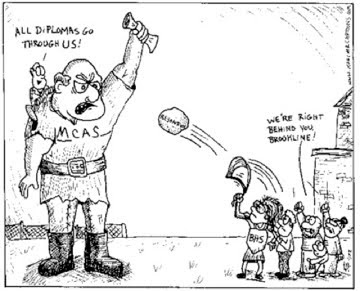This political cartoon appeared in 1861 criticizing the Presidency of James Buchanan. The cartoon shows the symbol of the U.S. , an eagle looking proud and distinguished in 1857, the year Buchanan would take office. By 1861, the year he was to leave the eagle is in tatters, a shadow of its former self.
Buchanan, a Democrat from Pennsylvania, is considered by most historians as being the worst President of the United States. His critics point out that he made many compromises to Southern States while in office and looked the other way during the Dred Scott Case and Bleeding Kansas. His own party would be in shambles over the issue of slavery and choose not to nominate him for re-election when his term expired.
The election of 1860, is one of the most crucial turning points in U.S. history. The outcome would lead to the dissolution of the Union and change the course of history.
The Democratic Party was in shambles in 1860. During the National Convention in Charleston South Carolina the Democrats failed to nominate a candidate to run for office. Fights broke out in the meeting hall and many Southern leaders call on a protest of the Convention. The Democratic leaders decided to halt the nomination process and to meet again in two weeks in Baltimore. Several delegates refused to attend the second convention and nominated John C. Breckinridge to be the Democratic Nominee for President. When the Convention ended in Baltimore, Stephen F. Douglas from Illinois was chosen to run for President. The Democrats had two candidates running for President, Douglas from the North and Breckinridge from the South.
The Republican Convention took place in Chicago and was much more unified then the Democrats. William Seward the Senator from New York seemed to be the front-runner to earn the nomination for President. However, many Republicans felt that he was too strongly opposed to slavery and that might lose him some votes in the Border States. On the third ballot, Abraham Lincoln from Illinois was chosen to be the Republican nominee for President because of his moderate stance on slavery.
A third party ran on the ballot for President. John Bell from Tennessee ran on the Constitutional Union Party ticket. Bell was for slavery and hoped to keep the Union together.
Douglas became the first Presidential Candidate to campaign across the nation. He spoke in both the North and South, trying to appeal to Americans to keep the nation together. Although he knew that he would not gain many votes in the South, he hoped to reach out to those who lived in Southern cities and to immigrant groups.
The Democrats hoped to block Lincoln from gaining enough votes in the Electoral College so the vote would be decided by the House of Representatives where they had control.
Despite the fact that Lincoln did not appear on the ballot on some states he won both the popular vote and the Electoral College. Douglas was second in the popular vote but only won the state of Missouri. Both Breckinridge and Bell did well in the South, but neither gained enough votes in the Electoral College to challenge Lincoln. If Lincoln ran against only one other candidate then the Democrats would have had a stronger chance of defeating him.


